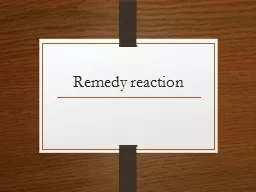

A correct interpretation of these changes enables him to arrive at certain conclusions about the further outcome of the case These changes also help him to judge the accuracy of his prescription regulate the administration of the remedy amp effect appropriate changes in the prescription from t ID: 934564
Download Presentation The PPT/PDF document "Remedy reaction The fine changes in the ..." is the property of its rightful owner. Permission is granted to download and print the materials on this web site for personal, non-commercial use only, and to display it on your personal computer provided you do not modify the materials and that you retain all copyright notices contained in the materials. By downloading content from our website, you accept the terms of this agreement.
Slide1
Remedy reaction
Slide2Slide3The fine changes in the symptomatology after a remedy is administered are easily missed unless the physician is quite alert.
A correct interpretation of these changes enables him to arrive at certain conclusions about the further outcome of the case.
Slide4These changes also help him to judge the accuracy of his prescription ,regulate the administration of the remedy & effect appropriate changes in the prescription from time to time
According to Hahnemann , the nearer similar the remedy the more reaction we may expect
.
Slide5Difference with Kent 12 observation
Two observations of Kent omitted by Dr.Roberts –action of medicine upon Prover & symptoms take wrong direction.
Roberts included one sided disease with prognosis.
Slide6AGGRAVATION
Killer’s aggravation
Borderline aggravation
Homoeopathic aggravation
Medicinal aggravation
Slide7REMEDY REACTION 1
PROLONGED AGGRAVATION & FINAL DECLINE OF THE PATIENT.
POSSIBILITIES-Too deep
antipsoric
-Vital energy –developed
destuctive
process
-It is an incurable case.
What to do-avoid giving high potency.
-Not to use an
antipsoric.However
, this applies only to those who are profoundly ill with chronic troubles.
Slide8REMEDY REACTION 2
A LONG AGGRAVATION BUT FINAL ALTHOUGH SLOW IMPROVEMENT
In cases where there is not so profound a disturbance, The aggravation may be long and severe, yet the final reaction & amelioration comes.
Borderline cases.
Slide9REMEDY REACTION 3
THE AGGRAVATION IS QUICK & SHORT AND STRONG , WITH RAPID IMPROVEMENT OF THE PATIENT.
POSSIBILITIES-The reaction is vigorous and there has been no structural change of the vital organs.
Slide10REMEDY REACTION 4
NO AGGRAVATION WHATSOEVER.
POSSIBILITIES-There is no organic change; there is no tendency to organic disease .
-remedy is not deep acting.
Slide11REMEDY REACTION 5
AMELIORATION COMING FIRST AND AGGRAVATION COMING AFTERWARD.
POSSIBILITIES-These are usually cases that have a great many symptoms.
-we selected superficial remedy which could act palliative only.
-Case is incurable AND the remedy was somewhat similar but not completely so.
Prognosis –
Unfavourable
Slide12WHAT TO DO?
-To determine the cause of reaction we must examine the patient
-find out whether the symptoms related to the remedy or to the disease.
-If the symptoms come back exactly as they were when you first saw the case, then must
wait,this
will require patience on the part of physician and co-operation on the part
of patient.
Slide13REMEDY REACTION 6
TOO SHORT A PERIOD OF RELIEF FROM SYMPTOMS
POSSIBILITIES-REMEDY-correct but-
The patient has been doing unconsciously something that is against the rules of health or has interfered with the continuation of the curative action of the remedy.
Slide14ACUTE CASE
The action of the remedy is much more quickly exhausted in rapid pace of acute disease than in the more moderate progress of chronic manifestation
WHAT TO DO?-MORE FREQUENT REPITITION OF REMEDY MAY BE DEMANDED.
Slide15CHRONIC CASE
If amelioration is too short in chronic
dis.,it
means that structural changes are taking place and have destroyed or threatened to destroy the proper functions of the patient.
Slide16REMEDY REACTION 7
A FULL PARIOD OF AMELIORATION OF THE SYMPTOMS, YET NO SPECIAL RELIEF OF THE PATIENT.
POSSIBILITIES-Advance structural change-they can improve to certain point.
What to do?-frequent
repitition
Slide17REMEDY REACTION8
SEEM TO PROVE ANY REMEDY YOU MAY GIVE THEM & GET AN AGGRAVATION FROM IT.
POSSIBILITY-Idiosyncrasy for the remedy.
-Too sensitive reaction of the vital energy.
Helpful in proving
Slide18REMEDY REACTION 9
RETURN OF FORMER SYMPTOMS THAT HAVE BEEN FORGOTTEN ,IT IS AN INDICATION THAT WE ARE CON THE RIGHT ROAD TO RECOVERY.
Hering’s
law of cure.
Slide19REMEDY REACTION 10
NEW SYMPTOMS APPEARING AFTER ADMINISTRATION OF REMEDY.
Wrong direction.